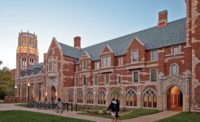Over the years, Manhattan Construction Co. has seen its revenue increase steadily, thanks to an expansive and diverse project portfolio and teams of dedicated employees. In Texas alone, the firm has grown to $632.5 million in 2016 from $233 million in 2011.
Manhattan’s presence in Texas dates back more than 70 years, and having experienced many periods of market volatility in that time, the firm’s leadership has built its business model around being diversified enough to ride out any single market fluctuation, explains Mark Penny, Manhattan’s senior vice president.
The contractor focuses primarily on two Texas markets: Dallas and Houston. While the Dallas market remains robust, uncertainty in the oil and gas sector is affecting the Houston area, Penny says.
“We are watching this closely and adjusting our business presence accordingly,” says John Reyhan, company president.
Combined with revenue of $55.46 million in Arkansas and $480.82 million in Oklahoma, the firm’s self-reported total for the region was $1.17 billion in 2016, boosting Manhattan to sixth on this year’s regional Top Contractors ranking.
“Texas and Oklahoma continue to be large markets for our vertical building business,” adds Larry Rooney, president of Manhattan Construction Group, the parent of Manhattan Construction Co. “The need for infrastructure improvements in Oklahoma and Arkansas have yielded results for our road, bridge and concrete business.”
Article Index:
Oklahoma Roots
Originally founded in 1896 in the Oklahoma Territory, Manhattan Construction Co. was the first company to incorporate in the new state and continues to call Oklahoma home. Over the past 121 years, the firm has expanded across the country and internationally into Mexico and the Caribbean.
Today, Manhattan Construction Group is comprised of six companies: Manhattan Construction Co., Manhattan Road & Bridge Co., Manhattan Pipeline LLC, Cantera Concrete Co., Spectrum Contracting Inc. and Safezone LLC. The firm maintains 12 offices throughout Arkansas, Oklahoma and Texas, both directly and through its subsidiaries, plus another five offices in Florida, Georgia and Washington, D.C.
Manhattan’s founding family still maintains a strong presence in the firm. Larry Rooney is a fifth-generation family member of founder L.H. Rooney.
“We pride ourselves on being one of the largest family-held construction firms in the country,” Rooney says.
Plentiful Projects
Despite the market slowdown that has coincided with low oil prices over the past year, particularly in Texas and Oklahoma, Manhattan has landed a steady stream of projects throughout the region.
“Our business plans are relatively simple. We focus on delivering the highest quality construction services across all of our platforms,” Rooney says. “Whether the jobs are small or larger, our dedication toward our mission of building excellence does not change. The actual quantity of projects from any given year to the next is not a major concern for us. Our focus remains on taking on challenges that we know we can deliver successfully.”
“We focus on delivering the highestquality construction services across all of our platforms.”
– Larry Rooney, President, Manhattan Construction Group
Some of the firm’s recent projects include the Trinity Terrace River Tower in Fort Worth, the Muscogee Creek Nation’s River Spirit Casino Phase II in Tulsa and Oklahoma State University’s Spears School of Business in Stillwater.
“We are fortunate that our work is spread across a variety of market sectors and not dependent on any single delivery method or project type,” Rooney says.
In 2015, Manhattan teamed with United Airlines on the $200-million Terminal C North expansion, a 14-gate replacement facility for the existing Terminal C that’s being demolished for the new Mickey Leland International Terminal at Bush Intercontinental Airport in Houston. Manhattan and United have a working relationship in Houston that dates back about 20 years, notes Brandon D. Fair, director of planning and development for United Airlines.
“United selected Manhattan as the construction manager at-risk, which allowed them to provide early schedule, cost and constructibility assistance. This up-front guidance and collaboration with the architect of record PGAL was critical to the success of the project,” Fair explains. “Manhattan’s knowledge of the construction market along with their professional estimating and scheduling capability was integral in developing the project execution strategy and provided a clear understanding of what we were to expect throughout the construction process.”
Work wrapped up on the job in March, on time and under budget, and “most importantly, the project was completed with no lost-time incidents, which is a testament to both United’s and Manhattan’s culture of making safety our number one priority,” Fair says.
The firm’s experience on previous jobs of similar size and scale enabled the team to apply that to United’s project, which was helpful when doing high-level planning for a project of that size and magnitude, he adds.
Another major Manhattan job was The Star in Frisco, the new headquarters for the Dallas Cowboys. The $359-million project was the first of its kind, which “marries up a professional sports franchise with a local independent school district [Frisco] to share resources and benefit the entire community,” Penny explains.
The firm also led the recent renovation of the center-field area at the Houston Astros’ Minute Maid Park.
“The project has a specific and tight timeline that began following the season and had to be completed prior to the start of our new season,” explains Marcel Braithwaite, senior vice president, business operations with the Astros.
Manhattan performed preconstruction and construction management duties after an extensive request for proposals and complex interview process. The firm’s experience in the world of sports and entertainment played a major part in the selection process, Braithwaite notes, since this was the first project Manhattan had done for the Astros.
“They understood the variables around a venue like ours and the importance of meeting deadlines and exceeding expectations,” Braithwaite says. “Every successful organization is defined by its people that represent it and how well they match skill to the needs of the project; for us, this was a home run. The project was a true partnership—values, ethics and strength of communication were exemplified by their team.”
Diversity as a Goal
Having a diversified business plan both in market sector type and project size helps drive success for the firm, Reyhan says. Manhattan’s team purposely targets small, medium and large-scale projects across a multitude of market sectors.
“We also balance between interest-rate-driven and non-interest-rate-driven projects to insulate the company from hikes in interest rates, which often delay or cancel projects,” he explains. “This approach leads to a far more predictable business plan and a nimble company. While we are well known for large, high-profile projects, the mainstay of the company are small and medium-size projects.”
A project of importance to Manhattan is the Oklahoma State Capitol restoration. The company built the 100-year-old structure and is now leading a full interior restoration of the facility in a project that spans from 2015 to 2022.
The complete restoration cost is $245 million, with $190 million of that being Manhattan’s responsibility, notes Trait Thompson, State Capitol project manager with the Oklahoma Office of Management and Enterprise Services.
As work has progressed in Oklahoma City, the Manhattan team has been “really creative” in coming up with solutions, Thompson adds. The building will remain fully occupied throughout the project.
“Manhattan has been great about working through those logistical challenges,” Thompson says. “They’re very proactive in working with architectural partner FSB to make sure that we can preserve as much of the original historical integrity of the building as possible.”
Upon completion, the project will leave behind a completely modern, 21st-century building inside the shell of a historic 1917 building, Thompson adds.
“It’s a fascinating and important project for the people of Oklahoma,” he says.
Staying Competitive
Maintaining a family culture is part of what keeps Manhattan competitive and differentiates the firm from others. “Finding clients who share in these values is the key to our successes,” Penny says.
Another includes a focus on improving preconstruction services. To do that, the firm has updated its preconstruction platform with an increased emphasis on early establishment of control budgets and control scope, Reyhan explains. “Establishing increased discipline in the budgeting process at the onset of design will set the stage for consistent budgeting through each phase,” he adds.
The firm continues to integrate best practices throughout its business. While there has been an overall slowdown in clients who ask for buildings that meet LEED requirements, for example, it hasn’t changed Manhattan’s approach.








Post a comment to this article
Report Abusive Comment